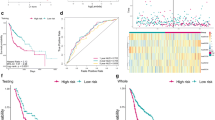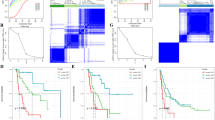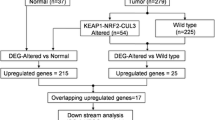Abstract
Purpose
Oral squamous cell carcinomas (OSCCs) are primary head and neck malignant tumours with a high incidence and mortality. However, the molecular mechanisms involved in OSCC tumorigenesis are not fully understood.
Methods
OSCC and paired para-carcinoma samples were collected and used to perform multi-omics study. Transcriptomic analysis was used to reveal significant alterations in inflammatory and immune processes in OSCC. Ingenuity Pathway Analysis (IPA) combined with the LASSO Cox algorithm was used to identify and optimize a crucial gene signature. Metabolomics analysis was performed to identify the important metabolites which linked to the crucial gene signature. The public data TCGA-HNSCC cohort was used to perform the multiple bioinformatic analysis.
Results
These findings identified a FN1-mediated crucial network that was composed of immune-relevant genes (FN1, ACP5, CCL5, COL1A1, THBS1, BCAT1, PLAU, IGF2BP3, TNF, CSF2, CXCL1 and CXCL5) associated with immune infiltration and influences the tumour microenvironment, which may contribute to OSCC tumorigenesis and progression. Moreover, we integrated the relevant genes with altered metabolites identified by metabolic profiling and identified 7 crucial metabolites (Glu-Glu-Lys, Ser-Ala, Ser-Ala, N-(octadecanoyl) sphing-4-enine-1-phosphocholine, N-methylnicotinamide, pyrrhoxanthinol and xanthine) as potential downstream targets of the FN1-associated gene signature in OSCC. Importantly, FN1 expression is positively correlated with immune infiltration levels in HNSCC, which was confirmed at the single-cell level.
Conclusions
Overall, these results revealed the differential genetic and metabolic patterns associated with OSCC tumorigenesis and identified an essential molecular network that plays an oncogenic role in OSCC by affecting amino acid and purine metabolism. These genes and metabolites might, therefore, serve as predictive biomarkers of survival outcomes and potential targets for therapeutic intervention in OSCC.








Similar content being viewed by others
Availability of data and materials
The datasets presented in this study can be found in online repositories. The names of the repository/repositories and accession number(s) can be found below: https://www.ncbi.nlm.nih.gov/, PRJNA876085 for transcriptomics raw data.
References
Advani J, Subbannayya Y, Gowda H, Chatterjee A (2017) Bioinformatics advances to accelerate omics innovations and applications in the postgenomic era. OMICS 21(12):750. https://doi.org/10.1089/omi.2017.0158
Bose S, Allen AE, Locasale JW (2020) The molecular link from diet to cancer cell metabolism. Mol Cell 78(6):1034–1044. https://doi.org/10.1016/j.molcel.2020.05.018
Cai X, Liu C, Zhang TN, Zhu YW, Dong X, Xue P (2018) Down-regulation of FN1 inhibits colorectal carcinogenesis by suppressing proliferation, migration, and invasion. J Cell Biochem 119(6):4717–4728. https://doi.org/10.1002/jcb.26651
Chai AWY, Lim KP, Cheong SC (2020) Translational genomics and recent advances in oral squamous cell carcinoma. Semin Cancer Biol 61:71–83. https://doi.org/10.1016/j.semcancer.2019.09.011
Chamoli A, Gosavi AS, Shirwadkar UP et al (2021) Overview of oral cavity squamous cell carcinoma: Risk factors, mechanisms, and diagnostics. Oral Oncol 121:105451. https://doi.org/10.1016/j.oraloncology.2021.105451
Chandrashekar DS, Bashel B, Balasubramanya SAH et al (2017) UALCAN: a portal for facilitating tumor subgroup gene expression and survival analyses. Neoplasia 19(8):649–658. https://doi.org/10.1016/j.neo.2017.05.002
Chaturvedi AK, Anderson WF, Lortet-Tieulent J et al (2013) Worldwide trends in incidence rates for oral cavity and oropharyngeal cancers. J Clin Oncol 31(36):4550–4559. https://doi.org/10.1200/jco.2013.50.3870
Chen Y, Gao Y, Yi X, Zhang J, Chen Z, Wu Y (2020) Integration of transcriptomics and metabolomics reveals the antitumor mechanism underlying shikonin in colon cancer. Front Pharmacol 11:544647. https://doi.org/10.3389/fphar.2020.544647
Cruceriu D, Baldasici O, Balacescu O, Berindan-Neagoe I (2020) The dual role of tumor necrosis factor-alpha (TNF-α) in breast cancer: molecular insights and therapeutic approaches. Cell Oncol (dordr) 43(1):1–18. https://doi.org/10.1007/s13402-019-00489-1
Dong Q, Wei L, Zhang MQ, Wang X (2018) Regulatory RNA binding proteins contribute to the transcriptome-wide splicing alterations in human cellular senescence. Aging (albany NY) 10(6):1489–1505. https://doi.org/10.18632/aging.101485
Eckert MA, Coscia F, Chryplewicz A et al (2019) Proteomics reveals NNMT as a master metabolic regulator of cancer-associated fibroblasts. Nature 569(7758):723–728. https://doi.org/10.1038/s41586-019-1173-8
Fan T, Pi H, Li M et al (2018) Inhibiting MT2-TFE3-dependent autophagy enhances melatonin-induced apoptosis in tongue squamous cell carcinoma. J Pineal Res 64(2):e12457. https://doi.org/10.1111/jpi.12457
Fan T, Wang X, Zhang S et al (2022) NUPR1 promotes the proliferation and metastasis of oral squamous cell carcinoma cells by activating TFE3-dependent autophagy. Sig Transduct Target Ther 7(1):130. https://doi.org/10.1038/s41392-022-00939-7
Fraga M, Yáñez M, Sherman M et al (2021) Immunomodulation of T helper cells by tumor microenvironment in oral cancer is associated with CCR8 expression and rapid membrane vitamin D signaling pathway. Front Immunol 12:643298. https://doi.org/10.3389/fimmu.2021.643298
Fujimura T, Aiba S (2020) Significance of immunosuppressive cells as a target for immunotherapies in melanoma and non-melanoma skin cancers. Biomolecules 10(8):1087. https://doi.org/10.3390/biom10081087
Gao Y, van Haren MJ, Moret EE et al (2019) Bisubstrate inhibitors of nicotinamide N-methyltransferase (NNMT) with enhanced activity. J Med Chem 62(14):6597–6614. https://doi.org/10.1021/acs.jmedchem.9b00413
Greten FR, Grivennikov SI (2019) Inflammation and cancer: triggers, mechanisms, and consequences. Immunity 51(1):27–41. https://doi.org/10.1016/j.immuni.2019.06.025
Gu W, Kim M, Wang L, Yang Z, Nakajima T, Tsushima Y (2021) Multi-omics analysis of ferroptosis regulation patterns and characterization of tumor microenvironment in patients with oral squamous cell carcinoma. Int J Biol Sci 17(13):3476–3492. https://doi.org/10.7150/ijbs.61441
Hong H, Xu J, He H et al (2022) Cadmium perturbed metabolomic signature in pancreatic beta cells correlates with disturbed metabolite profile in human urine. Environ Int 161:107139. https://doi.org/10.1016/j.envint.2022.107139
Hsu CW, Chen YT, Hsieh YJ et al (2019) Integrated analyses utilizing metabolomics and transcriptomics reveal perturbation of the polyamine pathway in oral cavity squamous cell carcinoma. Anal Chim Acta 1050:113–122. https://doi.org/10.1016/j.aca.2018.10.070
Jin Y, Qin X (2020) Comprehensive analysis of transcriptome data for identifying biomarkers and therapeutic targets in head and neck squamous cell carcinoma. Ann Transl Med 8(6):282. https://doi.org/10.21037/atm.2020.03.30
Krämer A, Green J, Pollard J Jr, Tugendreich S (2014) Causal analysis approaches in ingenuity pathway analysis. Bioinformatics 30(4):523–530. https://doi.org/10.1093/bioinformatics/btt703
Kujawa KA, Zembala-Nożyńska E, Cortez AJ, Kujawa T, Kupryjańczyk J, Lisowska KM (2020) Fibronectin and periostin as prognostic markers in ovarian cancer. Cells 9(1):149. https://doi.org/10.3390/cells9010149
Li L, Zhu Z, Zhao Y et al (2019) FN1, SPARC, and SERPINE1 are highly expressed and significantly related to a poor prognosis of gastric adenocarcinoma revealed by microarray and bioinformatics. Sci Rep 9(1):7827. https://doi.org/10.1038/s41598-019-43924-x
Li T, Fu J, Zeng Z et al (2020) TIMER2.0 for analysis of tumor-infiltrating immune cells. Nucleic Acids Res 48(W1):W509–W514. https://doi.org/10.1093/nar/gkaa407
Lin C, He H, Liu H et al (2019) Tumour-associated macrophages-derived CXCL8 determines immune evasion through autonomous PD-L1 expression in gastric cancer. Gut 68(10):1764–1773. https://doi.org/10.1136/gutjnl-2018-316324
Liu X, Meng L, Li X et al (2020) Regulation of FN1 degradation by the p62/SQSTM1-dependent autophagy-lysosome pathway in HNSCC. Int J Oral Sci 12(1):34. https://doi.org/10.1038/s41368-020-00101-5
Liu M, Pi H, Xi Y et al (2021) KIF5A-dependent axonal transport deficiency disrupts autophagic flux in trimethyl tin chloride-induced neurotoxicity. Autophagy 17(4):903–924. https://doi.org/10.1080/15548627.2020.1739444
Lyssiotis CA, Kimmelman AC (2017) Metabolic interactions in the tumor microenvironment. Trends Cell Biol 27(11):863–875. https://doi.org/10.1016/j.tcb.2017.06.003
Martínez-Reyes I, Chandel NS (2021) Cancer metabolism: looking forward. Nat Rev Cancer 21(10):669–680. https://doi.org/10.1038/s41568-021-00378-6
Nie Y, Huang H, Guo M et al (2019) Breast phyllodes tumors recruit and repolarize tumor-associated macrophages via secreting CCL5 to promote malignant progression, which can be inhibited by CCR5 inhibition therapy. Clin Cancer Res 25(13):3873–3886. https://doi.org/10.1158/1078-0432.Ccr-18-3421
Orlando N, Babini G, Chiusolo P, Valentini CG, De Stefano V, Teofili L (2020) Pre-exposure to defibrotide prevents endothelial cell activation by lipopolysaccharide: an ingenuity pathway analysis. Front Immunol 11:585519. https://doi.org/10.3389/fimmu.2020.585519
Qadir F, Lalli A, Dar HH et al (2019) Clinical correlation of opposing molecular signatures in head and neck squamous cell carcinoma. BMC Cancer 19(1):830. https://doi.org/10.1186/s12885-019-6059-5
Rahman J, Rahman S (2018) Mitochondrial medicine in the omics era. Lancet 391(10139):2560–2574. https://doi.org/10.1016/s0140-6736(18)30727-x
Reel PS, Reel S, Pearson E, Trucco E, Jefferson E (2021) Using machine learning approaches for multi-omics data analysis: a review. Biotechnol Adv 49:107739. https://doi.org/10.1016/j.biotechadv.2021.107739
Serafini MS, Lopez-Perez L, Fico G, Licitra L, De Cecco L, Resteghini C (2020) Transcriptomics and Epigenomics in head and neck cancer: available repositories and molecular signatures. Cancers Head Neck 5:2. https://doi.org/10.1186/s41199-020-0047-y
Sheng S, Guo B, Wang Z, Zhang Z, Zhou J, Huo Z (2021) Aberrant methylation and immune microenvironment are associated with overexpressed fibronectin 1: a diagnostic and prognostic target in head and neck squamous cell carcinoma. Front Mol Biosci 8:753563. https://doi.org/10.3389/fmolb.2021.753563
Sokratous G, Polyzoidis S, Ashkan K (2017) Immune infiltration of tumor microenvironment following immunotherapy for glioblastoma multiforme. Hum Vaccin Immunother 13(11):2575–2582. https://doi.org/10.1080/21645515.2017.1303582
Song J, Zhao D, Sun G, Yang J, Lv Z, Jiao B (2021) PTPRM methylation induced by FN1 promotes the development of glioblastoma by activating STAT3 signalling. Pharm Biol 59(1):904–911. https://doi.org/10.1080/13880209.2021.1944220
Sun D, Wang J, Han Y et al (2021) TISCH: a comprehensive web resource enabling interactive single-cell transcriptome visualization of tumor microenvironment. Nucleic Acids Res 49(D1):D1420-d1430. https://doi.org/10.1093/nar/gkaa1020
Sung H, Ferlay J, Siegel RL et al (2021) Global Cancer Statistics 2020: GLOBOCAN Estimates of Incidence and Mortality Worldwide for 36 Cancers in 185 Countries. CA Cancer J Clin 71(3):209–249. https://doi.org/10.3322/caac.21660
Tang Z, Li C, Kang B, Gao G, Li C, Zhang Z (2017) GEPIA: a web server for cancer and normal gene expression profiling and interactive analyses. Nucleic Acids Res 45(W1):W98-w102. https://doi.org/10.1093/nar/gkx247
Wang L, Jin H, Zeng Y et al (2022) HOXB4 Mis-regulation induced by microcystin-LR and correlated with immune infiltration is unfavorable to colorectal cancer prognosis. Front Oncol 12:803493. https://doi.org/10.3389/fonc.2022.803493
Wu F, Shi X, Zhang R et al (2018) Regulation of proliferation and cell cycle by protein regulator of cytokinesis 1 in oral squamous cell carcinoma. Cell Death Dis 9(5):564. https://doi.org/10.1038/s41419-018-0618-6
Wu L, Zhou Y, Guan Y et al (2021) Seven genes associated with lymphatic metastasis in thyroid cancer that is linked to tumor immune cell infiltration. Front Oncol 11:756246. https://doi.org/10.3389/fonc.2021.756246
Xiao S, Zhou L (2017) Gastric cancer: Metabolic and metabolomics perspectives (Review). Int J Oncol 51(1):5–17. https://doi.org/10.3892/ijo.2017.4000
Xiao M, Zhang J, Chen W, Chen W (2018) M1-like tumor-associated macrophages activated by exosome-transferred THBS1 promote malignant migration in oral squamous cell carcinoma. J Exp Clin Cancer Res 37(1):143. https://doi.org/10.1186/s13046-018-0815-2
Yang E, Wang X, Gong Z, Yu M, Wu H, Zhang D (2020) Exosome-mediated metabolic reprogramming: the emerging role in tumor microenvironment remodeling and its influence on cancer progression. Sig Transduct Target Ther 5(1):242. https://doi.org/10.1038/s41392-020-00359-5
Zhang H, Sun Z, Li Y, Fan D, Jiang H (2017) MicroRNA-200c binding to FN1 suppresses the proliferation, migration and invasion of gastric cancer cells. Biomed Pharmacother 88:285–292. https://doi.org/10.1016/j.biopha.2017.01.023
Zhang L, Liu Q, Mu Q et al (2020a) MiR-429 suppresses proliferation and invasion of breast cancer via inhibiting the Wnt/β-catenin signaling pathway. Thorac Cancer 11(11):3126–3138. https://doi.org/10.1111/1759-7714.13620
Zhang Z, Lin E, Zhuang H et al (2020b) Construction of a novel gene-based model for prognosis prediction of clear cell renal cell carcinoma. Cancer Cell Int 20:27. https://doi.org/10.1186/s12935-020-1113-6
Zollinger AJ, Smith ML (2017) Fibronectin, the extracellular glue. Matrix Biol 60–61:27–37. https://doi.org/10.1016/j.matbio.2016.07.011
Zuo L, Chen Z, Chen L et al (2021) Integrative analysis of metabolomics and transcriptomics data identifies prognostic biomarkers associated with oral squamous cell carcinoma. Front Oncol 11:750794. https://doi.org/10.3389/fonc.2021.750794
Funding
This work was supported by the project from Hainan Province Clinical Medical Center, the Natural Science Fund of Hunan Province of China (grant number 2022JJ30846, 2021JJ30978, 2020JJ580, the National Natural Science Foundation of China (grant numbers 81802716).
Author information
Authors and Affiliations
Contributions
TFF: conceptualization; YCP: data curation, formal analysis, methodology, validation, visualization, and writing—original draft; DHY and XXL: data curation, formal analysis, methodology, validation, and visualization; KW, WL, YXH, XYL, ZHR, and XY: data curation and investigation; TFF, ZYZ, and SZ: formal analysis, funding acquisition, project administration, supervision, validation, visualization, writing—review and editing. All authors have read and approved the final version of this manuscript.
Corresponding authors
Ethics declarations
Conflict of interest
None.
Informed consent
Informed consent was obtained from all subjects involved in the study.
Institutional review board statement
OSCC and paired para-carcinoma samples were collected from the Department of Oral and Maxillofacial Surgery, the Second Xiangya Hospital of Central South University. Informed consent was obtained from all participants in writing. The protocols were approved by the Clinical Research Ethics Committee of the Second Xiangya Hospital of Central South University (NO. JBWKQA001), and the provisions of the Helsinki Declaration were followed when conducting the research.
Additional information
Publisher's Note
Springer Nature remains neutral with regard to jurisdictional claims in published maps and institutional affiliations.
Supplementary Information
Below is the link to the electronic supplementary material.
Rights and permissions
Springer Nature or its licensor (e.g. a society or other partner) holds exclusive rights to this article under a publishing agreement with the author(s) or other rightsholder(s); author self-archiving of the accepted manuscript version of this article is solely governed by the terms of such publishing agreement and applicable law.
About this article
Cite this article
Peng, Y., Yin, D., Li, X. et al. Integration of transcriptomics and metabolomics reveals a novel gene signature guided by FN1 associated with immune response in oral squamous cell carcinoma tumorigenesis. J Cancer Res Clin Oncol 149, 6097–6113 (2023). https://doi.org/10.1007/s00432-023-04572-x
Received:
Accepted:
Published:
Issue Date:
DOI: https://doi.org/10.1007/s00432-023-04572-x




